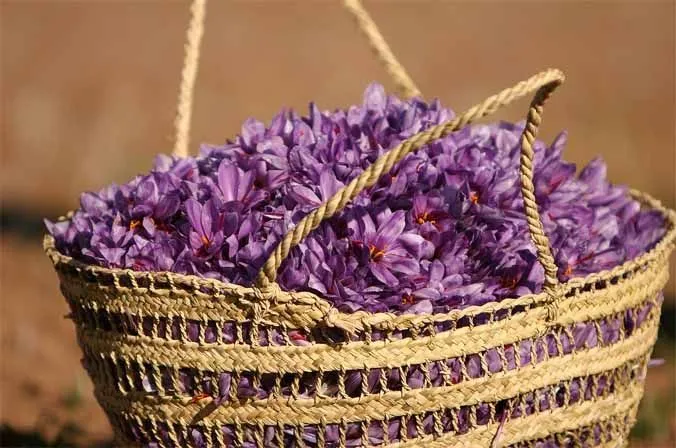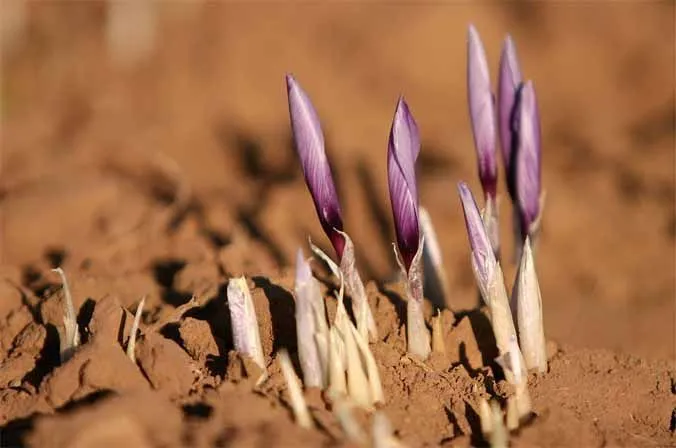The saffron it is a very typical condiment in many cuisines. In Spain, we usually use it to season rice, using simply one or two stigmas per serving. Above all, we look for the deep flavor that is obtained from it and the characteristic of dyeing everything that touches that characteristic yellow. However, moving away from gastronomy, it also has medicinal properties that we cannot forget.
Table of Contents
Botanical characteristics of saffron
Saffron is considered a herbaceous plant, bulbous, of the family of the Iridacéas. It has long, green and aligned leaves, which grow forming plumes.
Its origin is described in the East, where it has been cultivated since ancient times as a aromatic plant, dye and also as a medicinal plant.
In Spain, however, it is grown less and less due to its high price in the market, which has favored the use of other dyes of lower price and equal use, or even by the arrival of other countries products with cheaper prices (but of worse quality). Only in the area of La Mancha, saffron is still grown in Spain.
Use of saffron as a medicinal plant
If we analyze the stigma of saffron, the part that is normally used, many substances and essential oils with many properties for our body will appear, finding traces of flavonoids and heterosides (crocin) responsible for the coloring power that this plant has.
Saffron has been used for a long time for its many virtues, and today it continues with the same dynamic.
Of all the virtues that saffron possesses, those that are maintained today are those that refer to the stomach properties that confer A the crocin (the substance we have mentioned before), it is given lipid-lowering properties (lowering the level of lipids in the blood). Therefore, it is recommended in the following cases:
- Lack of appetite: low sexual desire.
- Asthenia: muscle weakness and general fatigue.
- Amenorrhoea: menstruation problems.
- Gingivitis: inflammation of the gums and tissues that support the teeth.
- Dental pains.
To take advantage of all these properties it is enough to use it as a condiment (with the typical rice we eat). In addition, this plant provides an appetizing and attractive color to many dishes.

Other ways to take advantage of saffron
- Infusion: between 15-30 mg of saffron are used per cup (200-250 ml). Of this infusion you can take up to 3 cups a day (always remember the maximum doses).
- Dust: with the precaution of not exceeding the doses indicated by the doctor, it is usually used as a carminative and accelerant of menstruation.
- Dye: in the form of tincture (extraction with ethyl alcohol or ethanol), the gums are directly rubbed, curbing the pains of gums and teeth.
Beware of the quantity…
In ancient times, it was known that large quantities of saffron resulted in toxic to our body (between 10 and 12 grams). Thus, it is known that it can cause abortions (in ancient times many women used it as an abortifacient, although many times the mother was also carried in front), causing large internal hemorrhages.
However, at the amounts that our economy allows us (we do not have to forget the high cost of stigmas), we cannot be further from the amounts necessary to cause such problems.
Flowering and harvesting season
What everyone is interested in about saffron are the Stigmata that are extracted from their flowering. That is why it is such an expensive condiment, since it requires a lot of work and a lot of difficulty to separate this part from the rest of the plant and its waste. As a curiosity to tell you that to extract a kilo of saffron we will need 100,000 flowers.
The saffron flowering it happens in late summer (and early fall). The collection of saffron stigmas varies according to the climate in which we find ourselves, but it is usually done from September to November.
The reason for its high price lies inn that to obtain a kilogram of saffron about a hundred thousand flowers are needed and in addition, the collection must be carried out by hand by specialized personnel. Saffron is actually the stigma of the flower of the same name; once it is obtained, it must be kept in airtight glass jars, since moisture spoils it; nor should I give it the light.

The cultivation of saffron
Many people have dared, as long as the weather accompanies, to plant a few meters of saffron, just out of curiosity to extract, even if it is, some stigmas and keep a small box. Here are some tips to achieve this goal.
This plant withstands a wide range of temperatures, ranging from -10 ºC to 40 ºC. Above all, in the climate Manchego the best conditions are given, (in summer it is very hot and in winter it is very cold).
Also very important are the soil characteristics where we plant the bulbs, either by the structure it has, the characteristics of its drainage, porosity, etc. Remember that it is a bulbous plant that needs a loose, fluffy, limestone and deep soil.
Plant care
The subscriber it is usually applied before planting the bulbs, several months in advance. The incorporation of organic matter into the soil is sufficient to guarantee the soil characteristics we need (hence the importance of compost on the ground).
Irrigation is not important, because as you have seen, it is grown in climates where there are no excesses of water. The rainy seasons are used to carry out irrigations of a large amount (a blanket) and infrequently.
Conserve bulbs for planting next year
The duration of saffron is about 3 years. Therefore, it is interesting to keep some bulbs for planting once the crop cycle has passed. The Bulbs, keeping them in containers at temperatures between 5 and 10 ºC.

